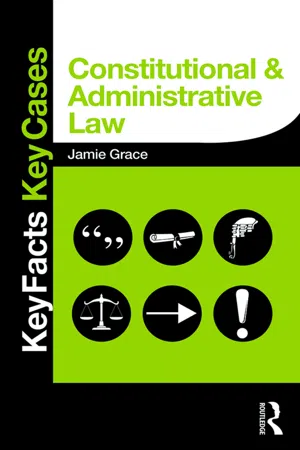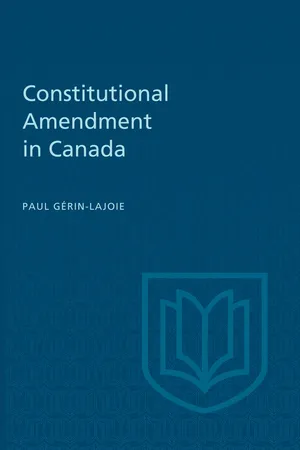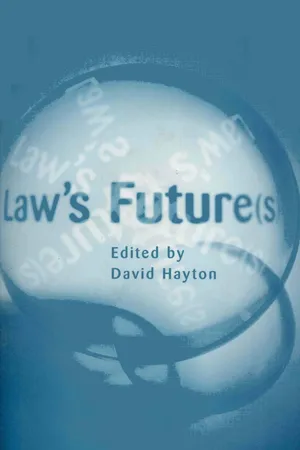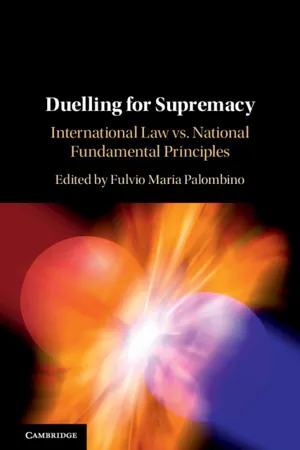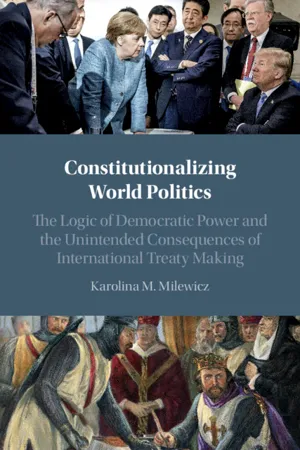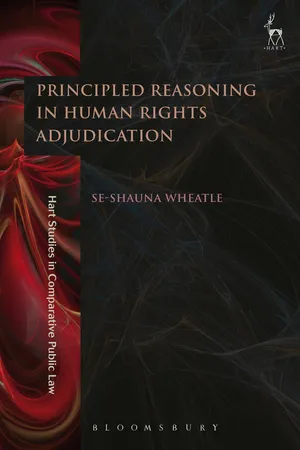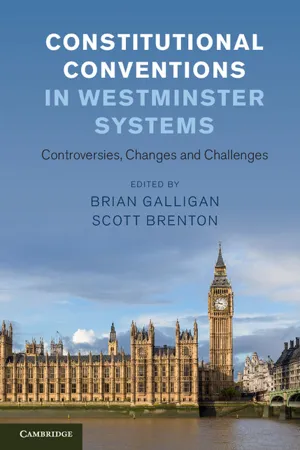Law
Constitutional Law UK
Constitutional law in the UK refers to the body of law that governs the structure and functioning of the country's government. It encompasses the principles and rules that define the powers and duties of the government institutions, as well as the rights and freedoms of the citizens. Constitutional law in the UK is derived from various sources, including statutes, common law, and conventions.
Written by Perlego with AI-assistance
Related key terms
1 of 5
10 Key excerpts on "Constitutional Law UK"
- eBook - PDF
- Ursula Smartt(Author)
- 2016(Publication Date)
- Routledge(Publisher)
The UK Constitution can then be defined as follows: it is more akin to an assemblage of laws, institutions, conventions and customs that compose the general constitutional set-up and system, according to which the British com- munity has agreed to be governed. The UK Constitution Primary legislation Common law Conventions EU law Secondary legislation Writers of authority 82 Optimize Public Law This means that the UK Constitution is a system of Government with a collection of rules which establish and regulate or govern the Government (see: Wheare, K.C., 1966, Modern Constitutions). The constitutional system is thus based on a combi- nation of Acts of Parliament and judicial decisions (common law), political practice (Conventions) and detailed procedures established by various organs of Govern- ment for carrying out their own tasks. Examples are the law and custom of Parlia- ment, Ministerial accountability in the form of rules issued by the Prime Minister to regulate the conduct of Ministers (e.g. the Ministerial Code). Examples of sources of UK Constitutional Law Common law (case law) Custom law Statutes Conventions (e.g. govermental rules; Ministerial Code) Advisory sources: writers of authority In the absence of a written UK Constitution, the writings of prominent constitu- tional lawyers have acquired great significance. Certain highly respected ‘institu- tional’ authors of law texts, written principally in the seventeenth, eighteenth and nineteenth centuries, have such high regard that they have been given a special place in the UK Constitution; they include: A.V. Dicey (The Law of the Constitution, 1885), Sir William Ivor Jennings (The Law and the Constitution, 1933; revised in 1959), Walter Bagehot (The English Constitution, 1867) and Stanley Alexander de Smith (Judicial Review of Administrative Action, 1959). The UK Constitution 83 One example is Dicey’s theory of the Rule of Law. - eBook - ePub
Constitutional and Administrative Law
Key Facts and Key Cases
- Jamie Grace(Author)
- 2015(Publication Date)
- Taylor & Francis(Publisher)
Part 1The development of constitutional and administrative law in the UKPassage contains an image
1 Contemporary and foundational issues in public law1.1 What is a constitution?1.1.1 A basic definition of a ‘constitution’ would be a body of rules regulating the way in which an organisation or institution operates. However, when the term ‘constitution’ is used in the context of a State’s constitution the definition is a little more complex.The constitution of a State would be expected to:- • establish the organs of government . Traditionally, this would consist of a body responsible for legislative functions; a body responsible for executive functions; and a body responsible for judicial functions;
- • allocate power between those institutions;
- • provide for the resolution of disputes on the interpretation of the constitution; and
- • establish procedures etc. for the amendment of the constitution .
1.1.2 The constitution therefore defines the relationship between the various institutions of the State (horizontal relationship ) and that between the State and the individual (vertical relationship ).1.1.3 In a narrow sense, a constitution could be defined as a particular document (or series of documents) setting out the framework and principal functions of the organs of government in a particular State. Such a constitution will have, as Wade describes, ‘special legal sanctity’, meaning that it is the highest form of law in the State.1.1.4 - eBook - PDF
- Paul Gérin-Lajoie(Author)
- 2019(Publication Date)
- University of Toronto Press(Publisher)
C H A P T E R I THE CONSTITUTION DEFINED THE constitution of a country, defined in general terms as the body of basic rules governing State organization and activity, may not always be readily determined as a distinct part of public law. The exact location of its common boundary with administrative law is a matter of convenience and personal choice which rests with each individual student of law or official codifier. In the United Kingdom, where there is no codified constitution, the sources of the body of rules which is called the British constitution are complex and are not distinct in form from the sources of the other branches of law. They lie partly in legislation; partly in judge-made law; partly in the law and custom of Parliament; partly in conventions which have grown up and have evolved according to changing needs. In continental Europe and, indeed, almost all over the world, there has been no smooth and progressive development of political institutions such as in Britain. From time to time, great revolutions have overturned the established order; or a nation has freed itself from the rule of a foreign master; or a new state has emerged from the union of smaller political units; or other analogous causes have brought the need for an extensive reshaping and a formal determination of political institutions. Moreover, the method of laying down rigid general principles has received more favour than under the flexible British system. As a result, it has long been the practice to embody most of the constitution in a single document intended to be the fundamental law of the country, although even here statute law, conventions, and rules developed by the courts, may still find an important place in the constitution. Never-theless they are only subsidiary sources, dependent on the fundamental law. For this reason, such a fundamental law, or the document containing it, is itself called the Constitution. 1 'Written with a capital C as being the title of a document. 3 - eBook - PDF
- David Hayton(Author)
- 2000(Publication Date)
- Hart Publishing(Publisher)
Constitutional and Human Rights Law CONOR GEARTY AND ADAM TOMKINS Introduction There is a sense in which every chapter in this book could be about human rights law. If we had to make one prediction about the future of UK law over the coming two decades or so it would be that rights-talk (and, increasingly, rights law) will figure ever more intrusively. Human rights might not come to dominate UK law, but they are set to become a domineering presence over it. We write here under the heading: Constitutional and Human Rights Law. The noun law reflects our belief that human rights law (as opposed to human rights) is a deeply technical subject, often quite distant from the noble political ideas of radical eighteenth century philosophy which fathered it. The constitutional dimension reflects our belief that a collection such as this should include at least some passing reference to the constitution, but more broadly we felt that, as public lawyers, one of the more arresting lessons of the Human Rights Act 1998 has already been how much the Act speaks to certain other areas of law more fundamentally than it appears to relate to constitu-tional law. While it might initially have been assumed that it would be consti-tutional lawyers who would embrace the Human Rights Act as a new aspect of their discipline, on further analysis it turns out that family lawyers, criminal procedure lawyers, and specialists in the law of evidence will all have to con-front the Human Rights Act more immediately and more urgently than will constitutional lawyers. But one critical task which the Human Rights Act will perhaps set constitutional lawyers, more pressingly than they are used to, is to crystallise the scope of their subject. In a sense, therefore, there is a critical ten-sion in our title, which raises the two questions on which we focus in this chap-ter. - eBook - PDF
Duelling for Supremacy
International Law vs. National Fundamental Principles
- Fulvio Maria Palombino(Author)
- 2019(Publication Date)
- Cambridge University Press(Publisher)
19 United Kingdom Eirik Bjorge and Ewan Smith 1 introduction The most obvious feature of the British Constitution is that it lacks a constitutional text. The most important feature, however, is the supremacy of Parliament. This rule – that what Parliament enacts is supreme law – Parliament cannot readily entrench a Constitution that would bind future parliaments. 1 This is one reason why Britain lacks a written constitution. Instead, the British Constitution reflects a combination of statute, common law rules laid down by the courts, and convention. 2 Because Britain lacks a constitutional text, it lacks an original constitutional moment. 3 Instead, it has a historical Constitution 4 – a series of moments stretching from Magna Carta 1215, through the Bill of Rights 1688 and the Treaty of Union 1707, to more recent legislation such as the European Communities Act 1972 and the Human Rights Act 1998. Certain British constitutional rules, both statutory and common law, predate the modern British constitutional settlement by many hun- dreds of years. People argue about which moments are most salient and this debate, in turn, shapes the meaning of modern rules. 5 Together these three features of the UK constitution – its unwritten nature, its historical span, and its supreme legislature – affect the way international law is received. First, there is no code that might serve as a guide, so we begin in this chapter by setting out some elementary rules which, in our view, shape the reception of international law in the UK. By the standards of some constitutional orders, these rules are highly deferential to Parliament. 1 Ellen Street Estates v Minister of Health [1934] 1 KB 590. 2 A. V. Dicey, Introduction to the Study of the Law of the Constitution (8th ed., Macmillan, 1915). 3 See B. Ackerman, We the People (Belknap Press, 1991). 4 See J. W. F. Allison, The English Historical Constitution: Continuity, Change and European Effects (CUP, 2007). - eBook - PDF
- Jean McFadden, Dale McFadzean(Authors)
- 2014(Publication Date)
- EUP(Publisher)
Each organ should be vested with one main function of government only and should not interfere with the functions of another. • It is debatable to what extent the separation of powers truly exists in the UK since there are a number of areas of overlap. In particular, the office of Lord Chancellor has been a constant refutation of the doctrine, however, this has been altered by the Constitutional Reform Act 2005. • The independence of the judiciary is a fundamental principle of the UK constitution. Judges must be free from the pressure of government in order to achieve fairness and impartiality and to this end their security of tenure is protected by a number of legal rules and Acts of Parliament. • Parliamentary sovereignty or the legislative supremacy of Parliament means that Acts of the UK Parliament are superior to any other source of law and that Parliament has unlimited law-making power. D O C T R I N E S O F T H E C O N S T I T U T I O N 17 • In modern times, parliamentary sovereignty has been somewhat eroded by a number of practical limitations, such as the UK’s membership of the EU, and other international obligations. • The rule of law is common to all civilised societies and represents an absence of arbitrary power. The rule of law recognises all citizens as being equal before the law and ensures that all state action is authorised by law. • Countries which subscribe to the rule of law ought to have adequate safeguards in place to protect citizens from abuse of discretionary power and should also be able to protect fundamental human rights. • Ministerial responsibility ensures that Ministers are responsible to Parliament for the administration of their individual departments, ie a Minister is accountable for not only personal decisions but also the actions and decisions of civil servants. • In most cases, attempts are made to invoke ministerial responsibility by parliamentary questions or debate. - eBook - PDF
Constitutionalizing World Politics
The Logic of Democratic Power and the Unintended Consequences of International Treaty Making
- Karolina M. Milewicz(Author)
- 2020(Publication Date)
- Cambridge University Press(Publisher)
3.3 Constitutionalization of Fundamental Rules Constitutions are fundamental in that they are superior to other rules and exceptionally stable due to special amendment procedures. Despite these commonalities, constitutionalization in the three examples reveals pro- foundly different bases of constitutional stability and supremacy. In the British legal system – where hierarchy of law is low and constitutional amendment procedures are nonexistent – the informal principle of 94 Part I: Constitutional Foundations parliamentary sovereignty has been the key to understanding its constitu- tional foundation. In the US Constitution, supremacy of federal law over state law and stability in terms of separation of powers have been made explicit in the constitutional document from the start. In the Swedish legal system – in which constitutional law is not sharply distinguished from ordinary law – constitutional stability is essentially a matter of public support. Thus, while stability and supremacy have become the founda- tional features common to most constitutions, they have very distinct origins. 3.3.1 Britain: Parliamentary Sovereignty The British constitution is unique with regard to its fundamental nature. Having an “indeterminate content” and an “indistinct structure” (Finer, Bogdanor, and Rudden 1995, 40–43), it is not as distinguishable from other laws such as parliamentary statutes, conventions, and practices. This relatively low hierarchy of law in the British legal system makes constitutional supremacy indiscernible. The British constitution is also exceptional with regard to its stability. It is considered an “unentrenched” constitution (Finer, Bogdanor, and Rudden 1995, 43). - eBook - ePub
- Hilaire Barnett(Author)
- 2019(Publication Date)
- Routledge(Publisher)
Chapter 1 . It was seen there that constitutional theorists fall into two main camps – the political constitutionalists and the legal constitutionalists. For the former, Parliament is the body which holds sovereign power on behalf of the people. Parliament, unlike the judges, is elected and accountable. For legal constitutionalists on the other hand, the idea that Parliament has unlimited power and that the judges as guardians of the common law are powerless to restrain that power is unacceptable. The common law underpins parliamentary supremacy, and if a government with a strong majority in Parliament should act unconstitutionally and attempt to undermine fundamental constitutional principles such as the rule of law, it would be for the courts to restrain Parliament. The judicial statements given below reflect the idea of shared, or bi-polar, sovereignty.Over 20 years ago, Lord Bridge of Harwich in X Ltd v Morgan Grampian Ltd (1991)56 stated that:The maintenance of the rule of law is in every way as important in a free society as the democratic franchise. In our society the rule of law rests upon twin foundations: the sovereignty of the Queen in Parliament in making the law and the sovereignty of the Queen’s courts in interpreting and applying the law.The idea that there could be two, rather than one, sovereign powers was suggested by Lord Woolf in Hamilton v Al-Fayed (1999)57 when he referred to the ‘wider constitutional principle of mutuality of respect between two constitutional sovereignties’. In R v Secretary of State for the Home Department ex parte Simms and O’Brien (1999)58 Lord Hoffmann considered sovereignty in light of the Human Rights Act 1998 and stated that:In the absence of express language or necessary implication to the contrary, the courts therefore presume that even the most general words were intended to be subject to the basic rights of the individual. In this way the courts of the United Kingdom, though acknowledging the sovereignty of Parliament, apply principles of constitutionality little different from those which exist in countries where the power of the legislature is expressly limited by a constitutional document. - Se-shauna Wheatle(Author)
- 2017(Publication Date)
- Hart Publishing(Publisher)
For an alternative account of UK and Australian courts’ treatment of priva-tive clauses, see David Dyzenhaus, The Constitution of Law: Legality in a Time of Emergency (Cambridge University Press, 2006) 102–17. values that transcend issues, political positions, and even institutions. This is not to suggest that multiple institutions and normative contingents mean the same thing when they speak or hear the language of the rule of law, and it is not to propose that there is no difference between the rule of law as legal principle, as political principle, and the rule of law in any of its other permutations. What is evident is that there is substantial power in this language, and this power sounds across institutions and across political factions. Accordingly, lawyers and judges are able to deploy rule of law language convincingly in a dialogue with the Executive and Parliament. The application of the rule of law and separation of powers by courts in the United Kingdom is affected and limited by the dominant constitu-tional principle operative in the UK Constitution: parliamentary supremacy. Indeed, parliamentary supremacy affects the constitutional balance that the courts seek to maintain, with courts acknowledging that their interpreta-tive exercise must ultimately bow to, and avoid trampling, parliamentary supremacy. The division of power shifts under written constitutions under which courts are empowered to invalidate unconstitutional legislation. Courts in such jurisdictions have been insistent that within a separation of powers construct, the courts would be entitled—in fact, duty-bound— to protect the rule of law against encroachments, even encroachments by Parliament.- eBook - PDF
Constitutional Conventions in Westminster Systems
Controversies, Changes and Challenges
- Brian Galligan, Scott Brenton(Authors)
- 2015(Publication Date)
- Cambridge University Press(Publisher)
The importance of constitutional context Individual conventions always operate in the context of a larger collec- tion of practices, norms and laws existing in a specific political commu- nity or among a group of related communities. Sometimes a particular convention is part of a relatively well-defined set of conventions. The core conventions of parliamentary responsible government operating within Westminster-derived systems are of this kind. Other conventions have a more discrete character. Although these conventions remain system-dependent, we unreflectively refer to them individually, in the singular and not in the plural. Examples include the Sewel convention in the United Kingdom, the patriation convention in Canada, and the presidential two-term convention in the United States (Neale 2009). Moreover, conventions mean different things in different contexts. Sometimes they operate to clarify the meaning of ambiguous language used in written constitutions or constitutional statutes; other times they supplement incomplete language or gaps in the law with specific proced- ures or practices necessary to give the law practical effect; and yet other times they contradict or displace the practical operation of rules of law by requiring legally discretionary powers to be exercised in certain ways or in accordance with particular expectations (Jones and Iyer 1989: 407–9). How these different kinds of conventions operate depends a great deal on constitutional context. Within a Westminster setting, the most important conventions are in the nature of duty-imposing rules that control the exercise of legally conferred powers, especially the prerogative powers of the Queen in the United Kingdom and her vice-regal representatives 28 nicholas aroney in Canada, Australia and New Zealand (Jaconelli 2005: 154–5; Sirota 2011: 30–1).
Index pages curate the most relevant extracts from our library of academic textbooks. They’ve been created using an in-house natural language model (NLM), each adding context and meaning to key research topics.

